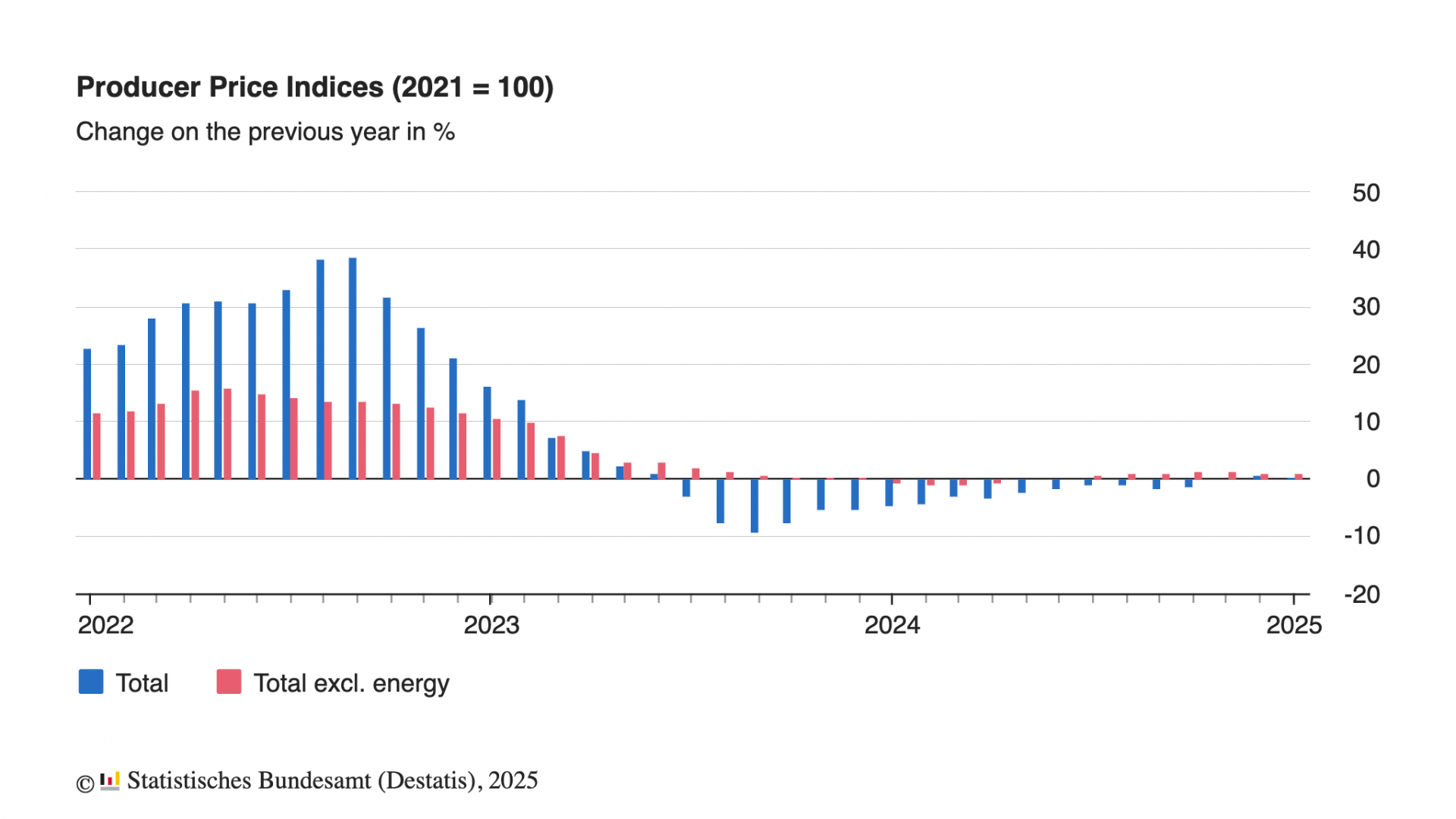2025-02-21
indicators

The Federal Statistical Office (Destatis) has reported that producer prices of industrial products in Germany were 0.5% higher in January 2025 compared to the same month in 2024. This marks a slowdown from the 0.8% increase recorded in December 2024. On a month-to-month basis, producer prices fell slightly by 0.1% from December 2024 to January 2025. The primary driver of the year-on-year increase in producer prices was the higher cost of non-durable consumer goods. Additionally, capital goods and durable consumer goods also recorded price increases, whereas energy and intermediate goods experienced a decline. When excluding energy prices, producer prices increased by 1.2% year-on-year and by 0.3% compared to the previous month. Energy prices in January 2025 continued their downward trend, falling by 1.0% compared to the same period last year. Compared to December 2024, energy costs declined by 0.9%, with the most significant impact coming from falling electricity prices, which dropped by 1.8% year-on-year and 2.5% from the previous month. Natural gas distribution costs also decreased by 1.9% compared to January 2024 and 2.8% from December 2024. Similarly, district heating was 1.5% cheaper on both an annual and monthly basis. However, the cost of mineral oil products increased, rising 0.7% year-on-year and 4.4% compared to the previous month. Heating oil prices surged by 1.9% from January 2024 and saw a significant 10.1% jump from December 2024, while motor fuel prices rose by 0.5% year-on-year and 5.6% month-on-month. Non-durable consumer goods recorded the most substantial price increase, rising by 3.0% year-on-year and 0.5% compared to December 2024. Food prices saw a significant uptick, with butter prices surging by 39.8% year-on-year, though they declined slightly by 0.3% from the previous month. Other notable increases included confectionery, which rose by 24.0% compared to January 2024, and beef prices, which climbed 18.0% on an annual basis. On the other hand, sugar prices saw a sharp decline of 33.8% compared to the previous year, while pork and cereal flours were 8.8% and 4.1% cheaper, respectively. Durable consumer goods were 1.1% more expensive than in January 2024, with a 0.4% increase compared to December 2024. Capital goods followed a similar trend, increasing by 1.9% year-on-year and 0.8% month-on-month. Machinery prices climbed by 1.9% compared to January 2024, while the cost of motor vehicles, trailers, and semi-trailers increased by 1.4%. Intermediate goods, however, saw a slight decline in prices, falling by 0.1% year-on-year. Compared to December 2024, prices remained unchanged. Notably, glass and glass products were 4.8% cheaper than a year earlier, with flat glass prices experiencing a sharp 16.4% decline. Feed for farm animals also saw a decrease of 1.3% compared to January 2024. Meanwhile, the cost of basic chemicals remained unchanged year-on-year. Certain intermediate goods recorded price increases. The prices of stone, gravel, sand, clay, and kaolin rose by 3.4% compared to January 2024, while plaster products for construction purposes saw a 4.6% increase. Additionally, the prices of electric transformers climbed 2.3%, and wiring and wiring devices became 1.0% more expensive. The wood industry also recorded a mixed trend. While the overall price of wood and wood products rose by 2.5% compared to January 2024, coniferous timber experienced a significant increase of 11.4%. Conversely, non-coniferous timber prices fell by 5.7%, and particle boards declined by 1.1%. In the metals sector, prices rose by a marginal 0.1% compared to January 2024 but declined by 0.1% from the previous month. Copper and semi-finished copper products saw a sharp increase of 9.4% year-on-year. In contrast, basic iron, steel, and ferro-alloys were 8.9% cheaper than in January 2024, while concrete reinforcing bars saw a 2.6% price drop year-on-year. The latest data indicate that while certain consumer goods continue to see price increases, declines in energy and select industrial commodities have helped to temper overall inflationary pressures in the German economy.

